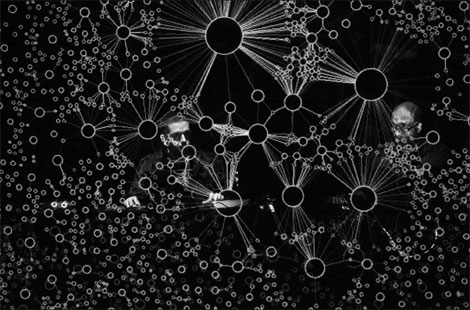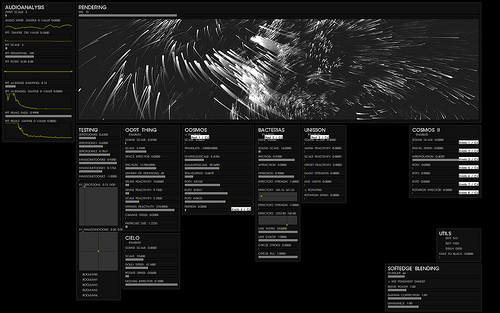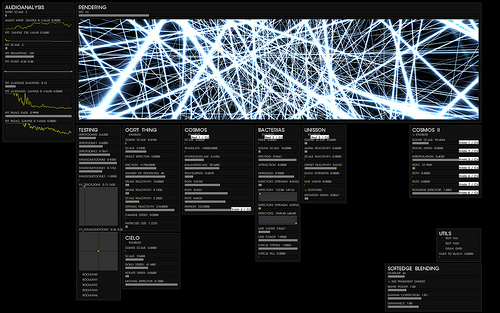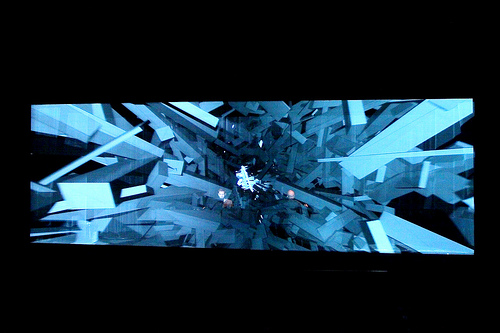Multimedia
Murcof and AntiVJ‘s Simon Geilfus @ Berlin Atonal
Yesterday we experience one of the most immersive experience with the collaboration between Mexican electronic composer Murcof and AntiVJ‘s Simon Geilfus at Berlin Atonal. With large, semi-transparent screens, they create a fully immersive environment in which microscopic particles, geometric grids and organic elements are mapped in wondrous 3D perspective to the sound of ambient and droning electronica. As amateurs pics I took with my iphone will not make justice to the show, I have collected some professional pics from this collaboration that already last 4 years (2009).




‘Five minutes of pure sculpture’, Anthony McCall @ Hamburger Bahnhof, August 11th, 2012
For the first time, the work of the New York-based artist Anthony McCall will be presented in a solo exhibition at a German museum. McCall’s unique projections, which he has been developing since the 1970s, exist at the boundaries between cinema, sculpture and drawing: animated lines are projected in a dark room filled with a light haze, allowing viewers to step into the beam of light and change its appearance.
The Hamburger Bahnhof will be showing works that McCall created beginning in 2003 after a 20-year break. While the early works are shown on 16 mm film, his more recent works are digital projections whose complex forms can only be created with the aid of computers. McCall’s horizontal works will be exhibited for the first time alongside his more recent vertical works, which bathe the exhibition space and the viewer in sculptural light.Curated by Henriette Huldisch.
Text source: http://www.hamburgerbahnhof.de/exhibition.php?id=32936&lang=en
Photographs by Paco Arteaga
‘db’, Ryoji Ikeda @ Hamburger Bahnhof, April 3rd, 2012
Japanese composer and visual artist Ryoji Ikeda has conceived an exhibition for the Hamburger Bahnhof that, for the first time, compositionally unites the two symmetrical halls on the upper level of the museum’s east and west wings. The exhibition’s title “db” (abbr. for decibel) refers to this symmetry while simultaneously indicating the complementary relationship between the two exhibition spaces. Ikeda has designed the white room and the black room as counterparts, not only physically (brightness, color), but also conceptually and perceptually. The project is a composition in which time and space are shaped through the most minimal use of sound, light and visual elements. It is the artist’s first solo exhibition in Germany.
The eponymous work “db” (2012) is centrally placed in both halls. In one room, it consists of a black super-directional parabolic loudspeaker that projects a pure wave of sound into the white space. The sound in the white room is reduced to a standing sine wave, the simplest musical building block. Every movement by a visitor alters the sonic field, allowing it to be experienced individually.
In the other room, a powerful searchlight projects a beam of white light into the black space. The beam of light in the black room is directed through a hole in a wall at one end of the space and thus becomes perceptible as a white circle. The beam consists of pure white light that, analogously to white noise, contains all the colors of the spectrum. Here, too, visitors’ movements alter the space; whenever they cross the beam of light, reflections illuminate the dark room.
Two other work complexes in the exhibition, “the irreducible [nº1-10]” (2009) and “the transcendental [nº4]” (2012), also complement each other. In the white room, the ten-part pigment print series “the irreducible”, which consists of over 1 million digits each rendered in black on black stands in contrast to the ten video projections of “the transcendental” in the black room, there, a transcendental number consisting of an infinite number of digits is luminously represented, zooming by at an ultra-fast frame rate while generating sounds in real time. Both works involve the representation of infinity based on mathematical research. Here the visitor can see respectively hear a tiny fragment of this endlessness in each space, as if through a window frame in the wall.
Since the mid-1990s, Ryoji Ikeda (born 1966, lives in Paris) has been among the foremost international composers and artists in the realm of cutting-edge digital technologies and their integration into visual and acoustic presentations. His works are based on spatio-temporal compositions in which the musical and visual material is reduced to a minimum: sine waves, sound pulses, pixels of light and numerical data. He investigates sound, time and space on the basis of mathematical methods and transforms them in his concerts and installations into an intense experience for the audience.
Curators: Ingrid Buschmann and Gabriele Knapstein.
Text source: http://www.hamburgerbahnhof.de/exhibition.php?id=32934&lang=en
data.anatomy [civic] by Ryoji Ikeda @ Kraftwerk Berlin, April 18th, 2012
data.anatomy [civic] is a new audiovisual installation by the acclaimed Japanese artist Ryoji Ikeda,arising from a unique collaboration with Mitsuru Kariya, the development leader of the new Honda Civic. Exhibited as a 3-screen video projection, data.anatomy [civic] immerses viewers in an intricate yet vast audiovisual composition derived from the entire data set of the car.
The unprecedented cooperation is the result of numerous discussions. They concluded with the artist invitation to explore the complete and uncensored technical vehicle data. In his work, Ikeda abstracts the complexity of the physical object into a captivated aesthetic experience.
“The core of my work is the composition of music, materials, physical phenomena and abstract concepts. In this project the invisible multi-substance of the vehicle data is subject of my composition” said Ryoji Ikeda. “As a Japanese artist, I have great respect for Honda’s long tradition of excellence and innovation in engineering. My installation verse on the diversity of ideas, beauty and ephemeral concepts that are embodied in the car”.
“Over the past four years my team and I were dedicated to the design and development of the new Civic. The way our work is interpreted by Ryoji Ikeda is an extraordinary honour for all of us”, says Mitsuru Kariya, technical director Honda Civic. “Everyone who is involved in the project, is thrilled by the result”.
The installation opened at MUMA (Kraftwerk) Berlin on April 19th and last till May 5th 2012.
The amaaaaazinggggg video shown below was created by data.anatomy team on the installation with some insights from Ryoji
 Free translation by me from original in german at http://www.mumaberlin.de/programm.html
Free translation by me from original in german at http://www.mumaberlin.de/programm.html
ReFunct Media #4 @ LEAP, April 13th, 2012
ReFunct Media is a multimedia installation that (re)uses numerous “obsolete” electronic devices (digital and analogue media players and receivers). These devices are hacked, misused and combined into a large and complex chain of elements. To use an ecological analogy they “interact” in different symbiotic relationships such as mutualism, parasitism and commensalism.
Voluntarily complex and unstable, ReFunct Media isn’t proposing answers to the questions raised by e-waste, planned obsolescence and sustainable design strategies. Rather, as an installation it experiments and explores unchallenged possibilities of ‘obsolete’ electronic and digital media technologies and our relationship with technologies and consumption.
LEAP (Lab for Electronic and Arts and Performance) presents ReFunct Media #4, a collaborative project by Benjamin Gaulon (IE/FR), Niklas Roy (DE), Karl Klomp (NL), Tom Verbruggen (NL) and Gijs Gieskes (NL).
In the slide show: Trash with attitude (object, in the slide show correspond to the picture that contains a display and machine with word FUCK YOU lighted-on) and Electronic Instant Camera (combination of analogue B&W videocamera and thermal receipt printer, pics from people in the opening located in the wall) by Niklas Roy, Crackle Canvas by Tom Verbruggen (it is a painting that produces sounds: circuitboards, speaker, knobs, switches, wood and canvas), Hypnotoad (hardware version of youtube video of Hypnotoad-character from TV series futurama) and GVS1b by Gijs Gieskes (viewfinder used as display and small security camera that films the person operating the GVS1b so it samples themselves) .
Video above: ReFunct media v4 exhibition-installation. The video is a walk through the installation.
Corrupt.Movie- B.Gaulon (fragment 25 secs). This single channel video is the collection of uploaded images on corrupt.recyclism.com since 2005. The total lenght of the video is 1h 11min 45 sec and includes 107175 images uploaded by thousands of different people from 2005 to 2011.
The opening exhibition included a live performance from TokTek(NL) and VJ MNK (Karl Klomp (NL)): 2 min excerpt in the video above.
Exhibition 14.04.-04.05.2012
Benjamin Gaulon is a researcher, artist and has a broad experience of acting as art consultant, public and conference speaker and art college lecturer. His work focuses on planned obsolescence, consumerism and disposable society. He has previously released work under the name “recyclism”. He is currently leading Data 2.0 (Dublin Art and Technology Association), he co-founded the IMOCA (Irish Museum of Contemporary) Art in 2007 and is lecturer at the National College of Art and Design in Dublin.Since 2005 he has been leading workshops and giving lectures in Europe and US about e-waste and hardware Hacking / Recycling. Workshop participants explore the potential of obsolete technologies in a creative way and find new strategies for e-waste recycling. His research seeks to establish an inter-disciplinary practice and collaborations by creating bridges between art, science and activism, and by doing so, shifting the boundaries between art, engineering and sustainable strategy.
Niklas Roy, born 1974 in Nurnberg, lives in Berlin since 1999 where he initially served as visual effects supervisor in the film industry and later studies Visual Communication at the University of the arts. Since then he has worked successfully as a freelance artist.The core of his work ranges from complex mechanics refined over electronics to purely virtual computer code that manifest themselves in objects, installations and performances.
Karl Klomp (‘79 – NL) is a media artist, vj and theater technician. His research focuses on live audiovisual expressions and interfacing with a fascination for glitch-art, hyper kinetic audio visuals and glitch grabbing. He deals with video circuit bending and hardware interfacing out of obsolete video devices. Together with Tom Verbruggen (Toktek) they play live audio-visual performances (toktek vs mnk).
TokTek (aka Tom Verbruggen) is a Dutch artist who designs and deconstructs his own electronic instruments, giving his music a unique character and allowing him to improvise live on stage with the help of a joystick – the central piece in his live equipment. Behind TokTek stands musician and visual artist Tom Verbruggen, who aside from building his own instruments is an improviser: synths, toys and computer become instruments.His eclectic electronic style has been described as illogical hardware bending, where the outcome creates dramatic live compositions, which break down into delicate and tender sound moments.In one of his incarnations, he performs with VJ MNK (Karl Klomp) – a video artist that hacks/bends video equipment like videomixers.
Gijs Gieskes, an educated industrial designer, he now most enjoys re-appropriating tools for new purposes, making inventive hardware projects; such as his Feedback video log, Strobo VJ machine or PCB hand-painted circuit board. His work and live performances are a fantastic example of where hardware hacking can take you.
‘Dark Drives’ exhibition videos part I @ TM – HKW, February 3rd, 2012
Dark Drives. Uneasy energies in technological times – videos – part I. Text source: exhibition catalogue.
Costanza, 2011 – Costanza Candeloro & Luca Libertini: Ever since the practical value of electricity was discovered in the first half of XIX century, close connections between human body and electricity have unfolded multiplicity of trajectories in our culture. Costanza gets in front of the camera touching her body with the tip of a mini jack cable connected to an amplifier. As she moves the cable over different parts of her skin, the current coming from the amplifier connected to the ground through her body and the sound of this electric circuit is heard on the loudspeakers connected to the amp. When she touches her covered parts, no sound is produced. The performance is reminiscent of a peepshow or sex internet video, except she is not striping nor sex, only her body and the electricity connected in a tense act of intimacy.
Armed citizens, 1998-2006. Daniel G. Andujar / Technologies To The People: Originally a website, is a series of images of handguns that can be bought online like the millions of other consumer goods the Internet offers the common user. The images simply present them one after objects of desire mode available by the new economy of digitalised network transactions. Hence, the “armed citizens” the title refers to, are, for whatever reason they buy guns, themselves the products of the commercial logic embedded in the contemporary access culture.
My Generation, 2010, Eva + Franco Mates aka 0100101110101101.org: If you were a teenage boy, what would you do if your mother cancelled your World of Warcraft account? screen like a pig, take off all your clothes, hit yourself with a shoe…? With material found online social platforms such youtube, Eva+Franco Mates demonstrates that computer games are far from mere recreational entertainment. They are extremely addictive and the games industry is fully aware of this. Gamers get hooked on the ‘high’ of the experience, but as any drug-infused high it is also destined to take control and produce effects such as frustration and rage…
Realigning My Thoughts On Jasper Johns, 2011, JK Keller: this is a glitch version of The Simpsons episode “Mom and Pop Art” (Season 10, Episode 19) in which the pop artist Jasper Johns appears as himself. Recalling Johns’ series of ecaustic collages begun in the 50s, Keller handles The Simpsons as mass-produced pop cultural object and distorts image and sound through the misappropiation of standardised software tools. The use Illustrator tool “Allignment abd Distribution” to process the video gives the name to the piece.
Transmediale: festival for art & digital culture 2k+12, opening “in/compatible” @ Haus der Kulturen der Welt, January 31st 2012
Transmediale title 2o12 is in/compatible and this year is the 25th anniversary of the festival. Transmediale engages reflective, aesthetic and speculative positions in between art, technology and culture. The festival articulate the relationship between technology and culture in non-linear, dynamic ways . Accordingly, transmediale is a transdisciplinary platform, always searching for new avenues of artistic, academic, activist and everyday expressions. It is a project always on the look out to re-model the production of contemporary culture.
During the opening: First pictures: Performance for prepared desktop by jon.satrom followed by Joshua Light Show and its psychedelic analogical art lighting.
TM also cooperates with club transmediale (CTM), which deals with electronic music and club culture.
in/compatible curatorial statement: When everything fails
Incompatibility is the condition arising when things are not working together. Given the current worldwide proclamations of crisis, be they political, financial, technological or environmental, it may seem as if incompatible elements and situations are everywhere, that everything is failing. Ironically, it is the supposedly ever-more compatible media-scape, where everything connects, that render such crises instantly visible. This raises the question if connective media and all-present data collection are even complicit in the production of crisis itself? Where do incompatibilities arise and how are they integrated in a world-order built on the paradox that it is predicated on convergence, but is in fact also constantly leading to divergence?
These are among the difficult questions we aim to tackle at transmediale 2012. With the theme in/compatible, the festival probes the productive and destructive sides of incompatibility as a fundamental condition of cultural production. To be in/compatible means to refuse a quick return to business as usual. It means to instead dare an investment in the unusual: aesthetic, ambiguous and nervous expressions of politics and technology that are contingent with the dark sides of network culture.
The too old and the too new are two sides of the same coin: nothing ever works perfectly.
Since years we have heard about the coming “promised land” of convergent technology, culture and economy as proclaimed by new media entrepreneurs, neo-liberal economists and development experts. Instead of a smooth operation, it is increasingly clear that processes of convergence bring about new tensions in everyday life,economy, politics and technology. Tensions and states of crisis are not contradictory to convergence which is instead a process that should be understood as dependent on the production of the incompatible.
“The media age proceeds in jerks, just like Turing’s paper strip,” Friedrich Kittler wrote, and in this he could just as well have been talking about technological development in general where the production of incompatibilities is central to having any development at all.
The simultaneous monumental failure and global ubiquity of technology seems to move us beyond the polarity of utopia and dystopia. Instead we are entering the blurred environments of the unadapted, monstrous and “uncorporated”. The increasingly unclear tension-states between open and closed, freedom and control, idealistic and commercial are giving rise to a new kind of “techno-cultural uneasy”. The in/compatible in this context is a singular moment of transversal reflection. Artists, hackers and tinkerers engage the imperfect nature of technology. They give it a cultural shape, developing a modular reflexivity that responds to the ever-changing social and economical terrains of the networked world.
transmediale 2012 is an in/compatible being, moving not necessarily forward.
More than a failed operation, incompatibilities lie at the heart of the governance of the inherent differences in network culture. This means that the incompatible is not the outside of networks but it is an internal and constant state of disruption which is necessary in order to enable the “open” state of a never completed system. Capitalism evolves according to the principle of “creative destruction”, as Joseph Schumpeter once formulated it. Allowing for incompatibility is central to the capitalist logic of always being “open to business”, the constant integration of new areas of production. But this does not necessarily mean that incompatibility always leads to co-optation. The in/compatible moment produces a gap in capitalist production, a temporary moment of stasis which may be used to reflect on where we are going, if anywhere at all, and on what conditions.
As an in/compatible being, transmediale 2012 highlights projects and cultural phenomena that saviour this stop in the incessant flow of things and posits it as a moment of tension that allows for a redefinition of our initial terms of engagement. The in/compatible being is one that moves with the particular rhythms of this tension, but not necessarily forward. Contrary to the fear of the incompatible, so prevalent in the age of cloud-computing, the festival raises the question of what happens when incompatibility is brought to the fore rather than hidden away in the dark underbelly of digital culture?





